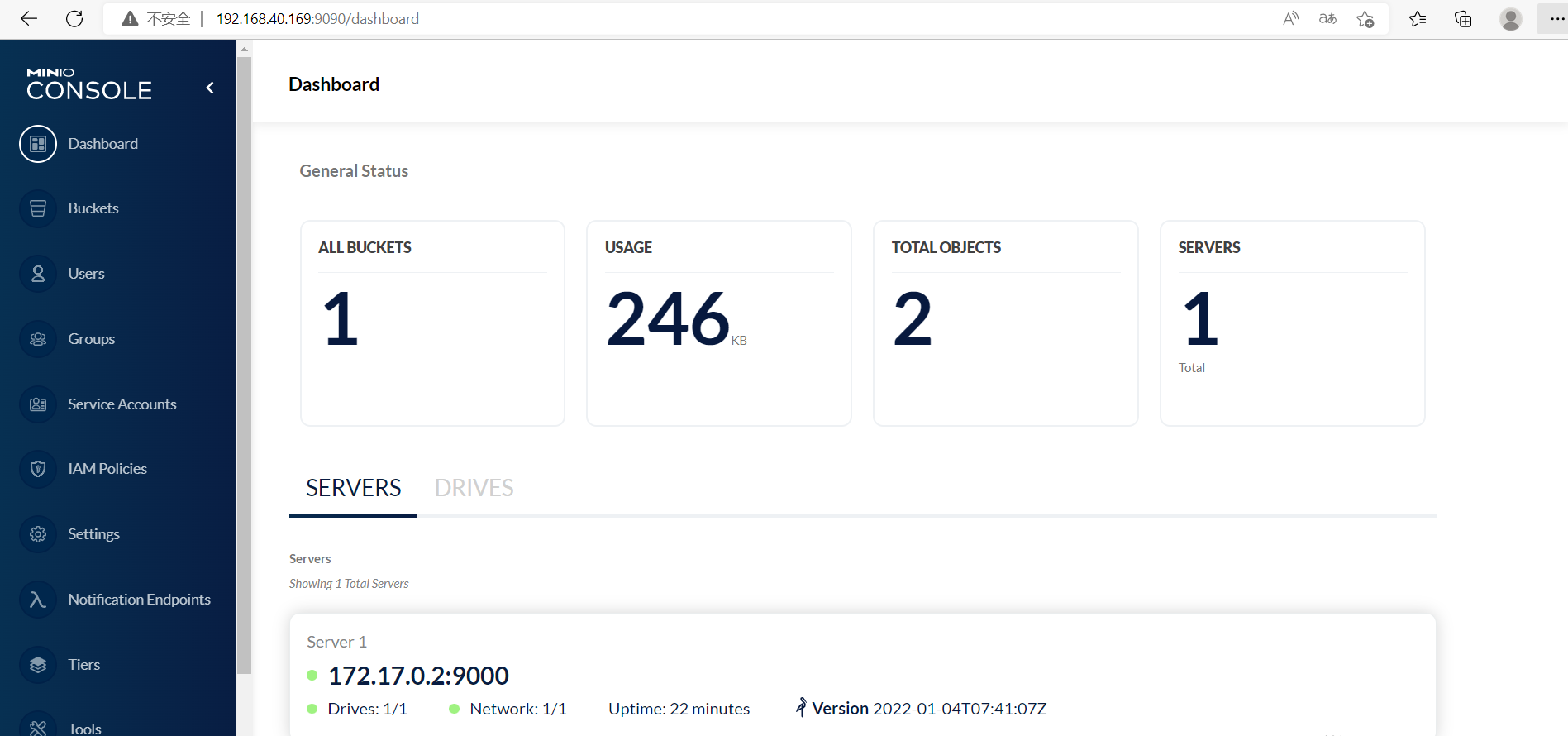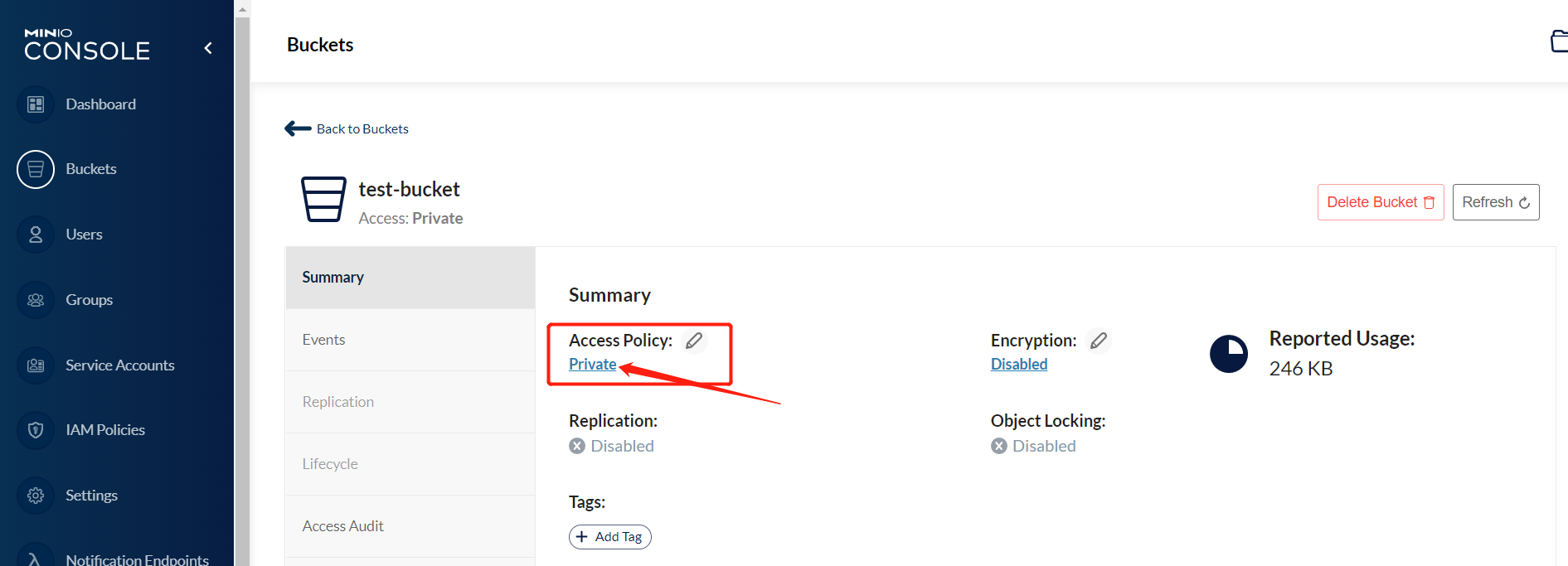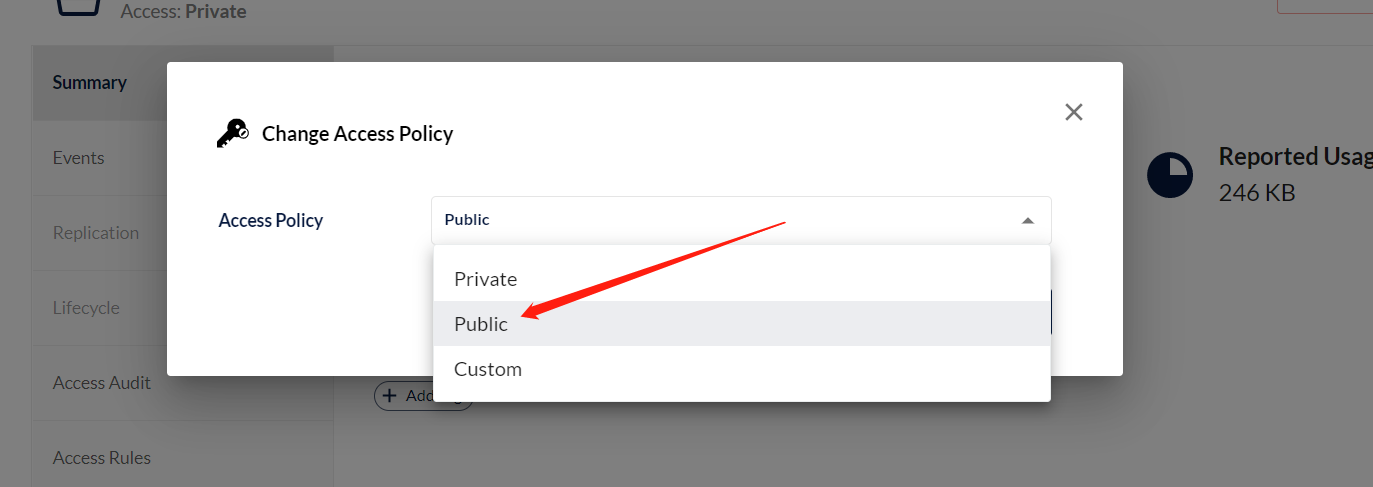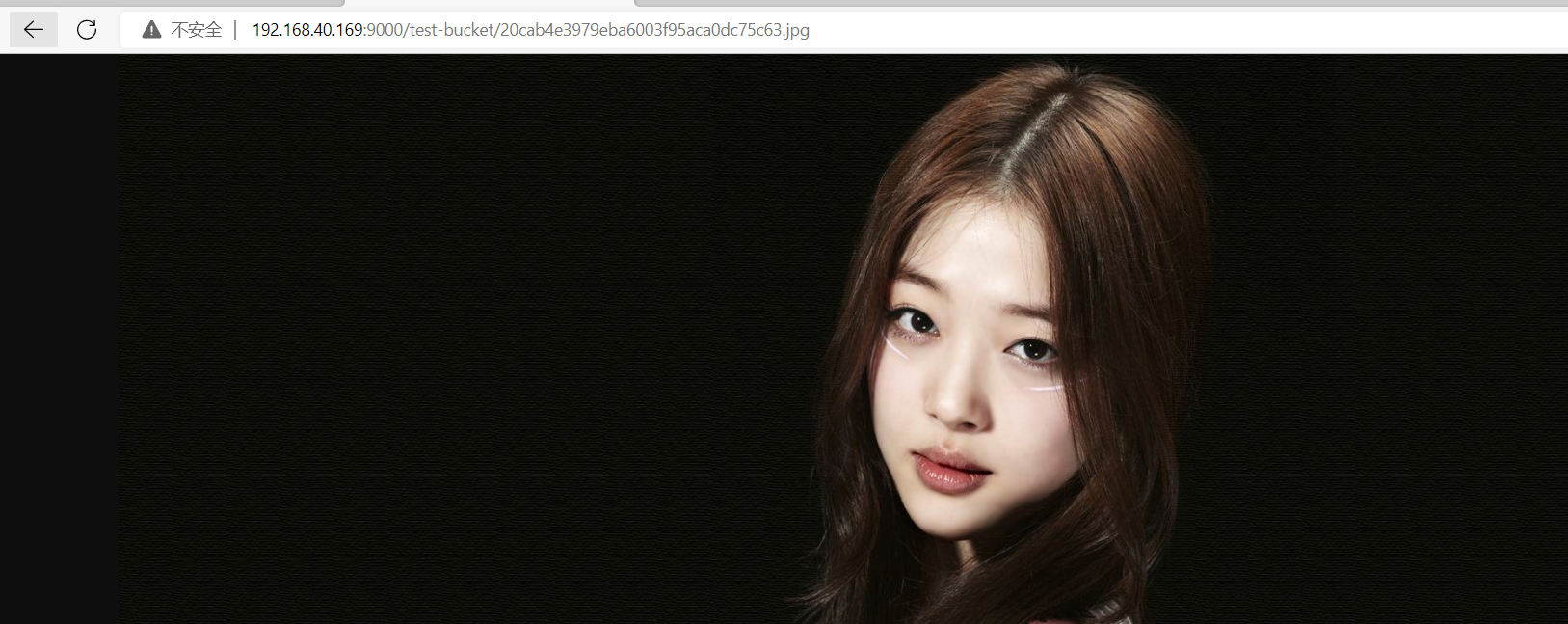SpringBoot 使用 Minio 进行文件存储
一、minio
MinIO 是一个高性能的对象存储原生支持 Kubernetes 部署的解决方案。 MinIO 提供了一个 Amazon Web Services S3 兼容 API 并支持所有核心 S3 功能。
MinIO 对象存储使用 buckets 来组织对象。 存储桶类似于文件系统中的文件夹或目录,其中每个 桶可以容纳任意数量的对象。 MinIO 存储桶提供 与 AWS S3 存储桶相同的功能。
其中 MinIO 的优势有:
-
高性能:
MinIO是全球领先的对象存储先锋,在标准硬件上,读/写速度上高达183 GB / 秒和171 GB / 秒。 -
可扩展性:
MinIO利用了web缩放器的来之不易的知识,为对象存储带来了简单的存储缩放模型, 在MinIO, 扩展从单个群集开始,该群集可以与其他MinIO群集联合以创建全局名称空间, 并在需要时可以跨越多个不同的数据中心。 通过添加更多集群可以扩展名称空间, 更多机架,直到实现目标。 -
云原生支持:
MinIO是在过去4年的时间内从0开始打造的一款软件 ,符合一切原生云计算的架构和构建过程,并且包含最新的云计算的全新的技术和概念。 其中包括支持Kubernetes、微服和多租户的的容器技术。使对象存储对于Kubernetes更加友好。 -
源码开放与企业级支持:
MinIO基于Apache V2 license 100%开放源代码 。 这就意味着MinIO的客户能够自动的、无限制、自由免费使用和集成MinIO、自由的创新和创造、 自由的去修改、自由的再次发行新的版本和软件. 确实,MinIO强有力的支持和驱动了很多世界500强的企业。 此外,其部署的多样性和专业性提供了其他软件无法比拟的优势。
在实验开始前请确保安装完成了 minio :

二、SpringBoot 使用 Minio 进行文件存储
首先新建一个 SpringBoot 项目,在 pom 中引入 minio 依赖:
<dependency>
<groupId>io.minio</groupId>
<artifactId>minio</artifactId>
<version>8.2.1</version>
</dependency>
- 1
- 2
- 3
- 4
- 5
在配置文件中,声明出 minio 的信息:
minio:
url: http://192.168.40.169:9000 # minio配置的地址,端口9000,注意不是控制台的端口
accessKey: minioadmin # 账号
secretKey: minioadmin # 密码
bucketName: test-bucket # MinIO桶名字
- 1
- 2
- 3
- 4
- 5
下面创建一个配置类,对 MinioClient 进行创建:
@Data
@Configuration
@ConfigurationProperties(prefix = "minio")
public class MinioConfig {
/**
* 服务地址
*/
private String url;
/**
* 用户名
*/
private String accessKey;
/**
* 密码
*/
private String secretKey;
/**
* 存储桶名称
*/
private String bucketName;
@Bean
public MinioClient getMinioClient() throws Exception {
MinioClient minioClient = MinioClient.builder().endpoint(url).credentials(accessKey, secretKey).build();
//判断桶是否存在,不存在则新建
if (!minioClient.bucketExists(BucketExistsArgs.builder().bucket(bucketName).build())){
minioClient.makeBucket(MakeBucketArgs.builder()
.bucket(bucketName)
.build());
}
return minioClient;
}
}
- 1
- 2
- 3
- 4
- 5
- 6
- 7
- 8
- 9
- 10
- 11
- 12
- 13
- 14
- 15
- 16
- 17
- 18
- 19
- 20
- 21
- 22
- 23
- 24
- 25
- 26
- 27
- 28
- 29
- 30
- 31
- 32
- 33
- 34
- 35
- 36
下面创建一个工具类 MinioTool 将常用的操作封装在工具类中:
@Component
public class MinioTool {
@Autowired
private MinioClient minioClient;
@Autowired
private MinioConfig minioConfig;
/**
* 查看存储bucket是否存在
*
* @param bucketName 存储bucket
* @return boolean
*/
public Boolean bucketExists(String bucketName) {
Boolean found;
try {
found = minioClient.bucketExists(BucketExistsArgs.builder().bucket(bucketName).build());
} catch (Exception e) {
e.printStackTrace();
return false;
}
return found;
}
/**
* 创建存储bucket
*
* @param bucketName 存储bucket名称
* @return Boolean
*/
public Boolean makeBucket(String bucketName) {
try {
minioClient.makeBucket(MakeBucketArgs.builder()
.bucket(bucketName)
.build());
} catch (Exception e) {
e.printStackTrace();
return false;
}
return true;
}
/**
* 删除存储bucket
*
* @param bucketName 存储bucket名称
* @return Boolean
*/
public Boolean removeBucket(String bucketName) {
try {
minioClient.removeBucket(RemoveBucketArgs.builder()
.bucket(bucketName)
.build());
} catch (Exception e) {
e.printStackTrace();
return false;
}
return true;
}
/**
* 查看文件对象
*
* @param bucketName 存储bucket名称
* @return 存储bucket内文件对象信息
*/
public Iterable<Result<Item>> listObjects(String bucketName) {
Iterable<Result<Item>> results = minioClient.listObjects(
ListObjectsArgs.builder().bucket(bucketName).build());
return results;
}
/**
* 批量删除文件对象
*
* @param bucketName 存储bucket名称
* @param objects 对象名称集合
*/
public Iterable<Result<DeleteError>> removeObjects(String bucketName, List<String> objects) {
List<DeleteObject> dos = objects.stream().map(e -> new DeleteObject(e)).collect(Collectors.toList());
Iterable<Result<DeleteError>> results = minioClient.removeObjects(RemoveObjectsArgs.builder().bucket(bucketName).objects(dos).build());
return results;
}
/**
* 文件上传
* 文件名称相同会覆盖
* @param file 文件
* @return Boolean
*/
public Boolean upload(MultipartFile file, String fileName) {
try {
if (!bucketExists(minioConfig.getBucketName())) {
makeBucket(minioConfig.getBucketName());
}
PutObjectArgs objectArgs = PutObjectArgs.builder().bucket(minioConfig.getBucketName()).object(fileName)
.stream(file.getInputStream(), file.getSize(), -1).contentType(file.getContentType()).build();
minioClient.putObject(objectArgs);
} catch (Exception e) {
e.printStackTrace();
return false;
}
return true;
}
/**
* 文件下载
*
* @param fileName 文件名称
* @param res response
* @return Boolean
*/
public void download(String fileName, HttpServletResponse res) {
GetObjectArgs objectArgs = GetObjectArgs.builder().bucket(minioConfig.getBucketName())
.object(fileName).build();
try (GetObjectResponse response = minioClient.getObject(objectArgs)) {
byte[] buf = new byte[1024];
int len;
try (FastByteArrayOutputStream os = new FastByteArrayOutputStream()) {
while ((len = response.read(buf)) != -1) {
os.write(buf, 0, len);
}
os.flush();
byte[] bytes = os.toByteArray();
res.setCharacterEncoding("utf-8");
//设置强制下载不打开
res.setContentType("application/force-download");
res.addHeader("Content-Disposition", "attachment;fileName=" + fileName);
try (ServletOutputStream stream = res.getOutputStream()) {
stream.write(bytes);
stream.flush();
}
}
} catch (Exception e) {
e.printStackTrace();
}
}
public String getFileUrl(String fileName){
return StringFormatter.concat(minioConfig.getUrl(), "/", minioConfig.getBucketName(), "/", fileName).getValue();
}
}
- 1
- 2
- 3
- 4
- 5
- 6
- 7
- 8
- 9
- 10
- 11
- 12
- 13
- 14
- 15
- 16
- 17
- 18
- 19
- 20
- 21
- 22
- 23
- 24
- 25
- 26
- 27
- 28
- 29
- 30
- 31
- 32
- 33
- 34
- 35
- 36
- 37
- 38
- 39
- 40
- 41
- 42
- 43
- 44
- 45
- 46
- 47
- 48
- 49
- 50
- 51
- 52
- 53
- 54
- 55
- 56
- 57
- 58
- 59
- 60
- 61
- 62
- 63
- 64
- 65
- 66
- 67
- 68
- 69
- 70
- 71
- 72
- 73
- 74
- 75
- 76
- 77
- 78
- 79
- 80
- 81
- 82
- 83
- 84
- 85
- 86
- 87
- 88
- 89
- 90
- 91
- 92
- 93
- 94
- 95
- 96
- 97
- 98
- 99
- 100
- 101
- 102
- 103
- 104
- 105
- 106
- 107
- 108
- 109
- 110
- 111
- 112
- 113
- 114
- 115
- 116
- 117
- 118
- 119
- 120
- 121
- 122
- 123
- 124
- 125
- 126
- 127
- 128
- 129
- 130
- 131
- 132
- 133
- 134
- 135
- 136
- 137
- 138
- 139
- 140
- 141
- 142
- 143
- 144
- 145
- 146
编写测试接口,进行测试:
@RestController
@RequestMapping("/file")
public class FileUploadController {
@Autowired
private MinioTool minioTool;
@PostMapping("/upload")
public ResponseEntity uploadFile(MultipartFile file) {
try {
String fileName = file.getOriginalFilename();
Boolean upload = minioTool.upload(file, fileName);
if (upload) {
return ResponseEntity.ok(minioTool.getFileUrl(fileName));
} else {
return ResponseEntity.status(400).body("上传失败!");
}
} catch (Exception e) {
return ResponseEntity.status(500).body(e.getMessage());
}
}
@GetMapping("/download/{fileName}")
public void download(@PathVariable("fileName") String fileName, HttpServletResponse response) {
minioTool.download(fileName, response);
}
}
- 1
- 2
- 3
- 4
- 5
- 6
- 7
- 8
- 9
- 10
- 11
- 12
- 13
- 14
- 15
- 16
- 17
- 18
- 19
- 20
- 21
- 22
- 23
- 24
- 25
- 26
- 27
- 28
三、测试
测试上传文件:

如果使用 返回的 url 直接访问文件,可以发现返回权限不足:

这里需要改一下 Bucket 的 Access Policy ,默认为 private,可以修改为 public 便无需认证,但安全性无法保证:



再次进行访问,文件就可以打开了:

如果需要保持 private ,可以通过 MinioClient 进行下载,使用 download 测试接口下载文件:
http://localhost:8080/file/download/20cab4e3979eba6003f95aca0dc75c63.jpg
- 1

文章来源: blog.csdn.net,作者:小毕超,版权归原作者所有,如需转载,请联系作者。
原文链接:blog.csdn.net/qq_43692950/article/details/125961685
- 点赞
- 收藏
- 关注作者


评论(0)